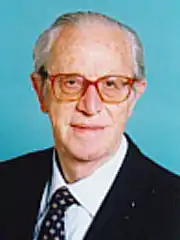Adriano Ossicini
Adriano Ossicini (20 June 1920 – 15 February 2019) was an Italian partisan, politician, academic, and Minister for Family and Social Solidarity in the Dini Cabinet.
Adriano Ossicini | |
|---|---|
 | |
| Minister for Family and Social Solidarity | |
| In office 17 January 1995 – 17 May 1996 | |
| Prime Minister | Lamberto Dini |
| Preceded by | Antonio Guidi |
| Succeeded by | Livia Turco (Social Solidarity) |
| Member of the Senate | |
| In office 5 June 1968 – 22 April 1992 | |
| In office 9 May 1996 – 29 May 2001 | |
| Personal details | |
| Born | 20 June 1920 Rome, Italy |
| Died | 15 February 2019 (aged 98) Rome, Italy |
| Nationality | Italian |
| Political party | SI (1968-1992) RI (1996-2001) DL (2002-2007) PD (2007-2019) |
| Occupation | Medic, University professor, politician |
Biography
Ossicini was born in Rome on June 20, 1920.[1][2]
During the Fascist regime
Ossicini's father, Cesare, was a lawyer and one of the founders of the Italian People's Party.[1] He enrolled at the Faculty of Medicine of the University of Rome, two years in advance. In December 1937, while still a student, he became a volunteer at the Fatebenefratelli Hospital on the Tiber Island in Rome.[3]
In April 1938, at a FUCI conference held in Orvieto, Ossicini supported the anti-fascist movement. Once he returned to Rome, he was interrogated and filed by the fascist police. In October of the same year, at a new conference of FUCI in Genoa, he appealed to Italian Catholics against racism and against fascism, accusing the regime of connivance with nazism.[3]
Ossicini disagreed with Alcide De Gasperi on his project regarding the reconstitution of a single party of Catholics, the future Christian Democracy, placed at the center of the political alignment.[3]
On 18 May 1943, Ossicini was arrested by the fascists during a raid and was imprisoned for more than two months.[4] Despite being violently beaten for a few days, he only admitted that he has expressed criticism of the racial legislation of fascism, since it was contrasting with the Christian Doctrine. On this occasion he heard the word "cattocomunista" for the first time from the fascist police.[3]
On 30 September 1943, Ossicini received a letter from Giulio Andreotti, in which the future Prime Minister expressed "in the name of the Pope" the opposition to an unconditioned collaboration between Catholics and the Italian Communist Party. Ossicini, with a note, replied that he disagreed with Andreotti.[3] Ossicini would claim that the catholic hospital he was working at also received orders from the pope to admit as many Jews as possible, something he claims led to his supposed creation of the syndrome K.[5][6][7] During World War II, Ossicini became one of the founders of the Party of the Christian Left, close to the Italian Communist Party; the party dissolved in 1945 after that L'Osservatore Romano reaffirmed that only the Christian Democracy was entitled to represent Christians in politics.[4][8]
After World War II
Ossicini graduated in Medicine at the end of 1944 and was admitted as a volunteer assistant at the Fatebenefratelli Hospital. He enrolled in the specialization course in Psychiatry, dealing with nervous and mental diseases; in 1947 he became a University professor of Psychology at the Sapienza University of Rome.
In 1968, Ossicini returns to politics and is elected to the Italian Senate as an independent in the PCI list and joined the group of the Independent Left; Ossicini confirmed his seat at Palazzo Madama uninterruptedly from 1968 to 1992.[2] Between 1970 and 1989 he has been the promoter of the law for the establishment of the Order of Psychologists.[9] He has also been Vice-president of the Senate from 1979 to 1983 and from 1985 to 1987.
In 1995 he became Minister for Family and Social Solidarity of the Dini Cabinet. He joined Lamberto Dini's Italian Renewal and was re-elected for the last time in the Senate in 1996.[2] In 2001 he moved to The Daisy and then in 2007 to the Democratic Party.[10]
References
- Gallo, Patrick J. (2003). For Love and Country: The Italian Resistance. University Press of America. ISBN 978-0-7618-2496-1.
- "senato.it - Scheda di attività di Adriano OSSICINI - XIII Legislatura". www.senato.it. Italian Senate. Retrieved 2020-11-19.
- Ossicini, Adriano (1999). Un'isola sul Tevere [An island on the Tiber] (in Italian). Rome: Editori Riuniti. ISBN 8835946905.
- Rychlak, Ronald J. (2005). Righteous Gentiles: How Pius XII and the Catholic Church Saved Half a Million Jews from the Nazis. Spence Publishing Company. ISBN 978-1-890626-60-0.
- Marchione, Margherita (2002). Consensus and Controversy: Defending Pope Pius XII. Paulist Press. ISBN 978-0-8091-4083-1.
- Riccardi, Andrea (2012-05-18). L'inverno più lungo: 1943-44: Pio XII, gli ebrei e i nazisti a Roma (in Italian). Gius.Laterza & Figli Spa. ISBN 978-88-581-0371-5.
- Momigliano, Anna (June 23, 2016). "Roman hospital awarded for inventing an 'infectious disease' to save Jews during WWII". Haaretz.com. Retrieved 2020-11-19.
- Airò, Antonio (20 April 2010). "Resistenza a Roma, i cattolici clandestini". Avvenire (in Italian). Retrieved 30 September 2018.
- "Legge n. 56 del 18 febbraio 1989 - Ordinamento della professione di psicologo". Consiglio Nazionale Ordine Psicologi (in Italian). Retrieved 30 September 2018.
- "Donne e Uomini della Resistenza: Adriano Ossicini". anpi.it (in Italian). 7 November 2010. Retrieved 30 September 2018.